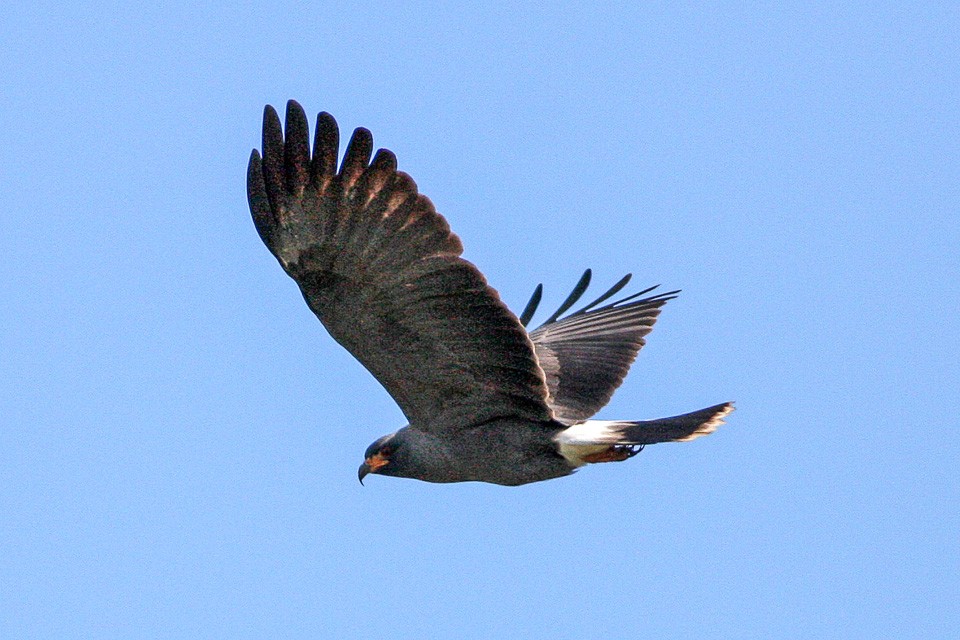Snail Kite
A species of Snail Kites Scientific name : Rostrhamus sociabilis Genus : Snail Kites
Snail Kite, A species of Snail Kites
Botanical name: Rostrhamus sociabilis
Genus: Snail Kites
Content
Description People often ask General Info
Description
Snail kites are 36 to 48 cm (14 to 19 in) long with a 99–120 cm (39–47 in) wingspan. They weigh from 300 to 570 g (11 to 20 oz). There is very limited sexual dimorphism, with the female averaging only 3% larger than the male. They have long, broad, and rounded wings, which measure 29–33 cm (11–13 in) each. Its tail is long, at 16–21 cm (6.3–8.3 in), with a white rump and undertail coverts. The dark, deeply hooked beak, measuring 2.9–4 cm (1.1–1.6 in) is an adaptation to its diet. The tarsus is relatively long as well, measuring 3.6–5.7 cm (1.4–2.2 in). The adult male has dark blue-gray plumage with darker flight feathers. The legs and cere are red. The adult female has dark brown upperparts and heavily streaked pale underparts. She has a whitish face with darker areas behind and above the eye. The legs and cere are yellow or orange. The immature is similar to adult female, but the crown is streaked. It flies slowly with its head facing downwards, looking for its main food, the large apple snails. For this reason, it is considered a molluscivore. 
Size
41-46 cm (16-18 in)
Life Expectancy
17 years
Nest Placement
Shrub
Clutch Size
1 - 5 eggs
Incubation Period
1 brood
Number of Broods
24 - 30 days
Nestling Period
26 - 30 days
Feeding Habits
Snail Kite predominantly consume freshwater apple snails, mainly the native Florida apple snail and invasive species. They forage by skimming shallow waters from a perch or in flight, seizing snails with talons before consuming them. Occasionally, snail Kite may eat small turtles, crayfish, snakes, fish, other snail types, and crabs, especially in South America.
Habitat
Snail Kite's habitat primarily encompasses low-altitude freshwater marshes, lakes, and canals, especially in warm climates. Clear water with aquatic vegetation like sawgrass and water lilies is crucial for their foraging. They generally steer clear of murky waters and dense vegetation. During droughts, these birds may traverse to alternative wetlands.
Nest Behavior
The male snail Kite selects the nest site and constructs the bulky nest, with the female assisting in its maintenance. Nest building coincides with the availability of food resources in nearby feeding areas, suggesting a strategic timing linked to breeding conditions and food availability. After the nest is built, the female lays eggs, and both parents are involved in caring for the eggs and young.
Nest Characteristics
Snail Kite's nest is typically located in trees beside or in shallow water under 30 feet tall, sometimes on shrubbery or emergent vegetation like sawgrass. Constructed mainly from dry sticks and branches, often willow and myrtle, lined with fresh leaves, reeds, and grasses, the nest averages 16 inches wide, 9 inches tall, with a 6-inch-wide, 2.4-inch-deep cup.
Dite type
Aquatic invertebrate eater
People often ask
General Info
Feeding Habits
Bird food type
Sounds
Call
Recording location: Brazil
Call
Recording location: Venezuela
Behavior
The snail Kite displays notable courtship rituals including 'roller coaster' and 'butterfly' flights, often with stick carrying and vocalizations. Males attract females with these aerial displays and by offering sticks and food. Monogamous during breeding, snail Kites share responsibilities of incubation and nest protection in loose colonies. While both parents initially attend to the young, one may leave to start another brood. They exhibit 'sequential monogamy' and show no preference whether fledglings are raised by one or both parents. Post-nesting, snail Kites often roost communally with other bird species and may exhibit 'natal philopatry', returning to breed near their birth site. Largely non-migratory, some may relocate slightly in extreme cold.
Distribution Area
The snail kite breeds in tropical South America, the Caribbean, and central and southern Florida in the United States. It is resident all-year in most of its range, but the southernmost population migrates north in winter and the Caribbean birds disperse widely outside the breeding season. It nests in a bush or on the ground, laying 3–4 eggs. The snail kite is a locally endangered species in the Florida Everglades, with a population of less than 400 breeding pairs. Research has demonstrated that water-level control in the Everglades is depleting the population of apple snails. However, this species is not generally threatened over its extensive range. In fact, it might be locally increasing in numbers, such as in Central America. In El Salvador, it was first recorded in 1996. Since then, it has been regularly sighted, including immature birds, suggesting a resident breeding population might already exist in that country. On the other hand, most records are outside the breeding season, more indicative of post-breeding dispersal. In El Salvador, the species can be observed during the winter months at Embalse Cerrón Grande, Laguna El Jocotal, and especially Lago de Güija. Pomacea flagellata apple snails were propagated in El Salvador between 1982 and 1986 as food for fish stocks, and it seems that the widespread presence of high numbers of these snails has not gone unnoticed by the snail kite. This is a gregarious bird of freshwater wetlands, forming large winter roosts. Its diet consists almost exclusively of apple snails. Snail kites have been observed eating other prey items in Florida, including crayfish in the genus Procambarus and black crappie. It is believed that snail kites turn to these alternatives only when apple snails become scarce, such as during drought, but further study is needed. On 14 May 2007, a birdwatcher photographed a snail kite feeding at a red swamp crayfish farm in Clarendon County, South Carolina. 
Species Status
Not globally threatened.
